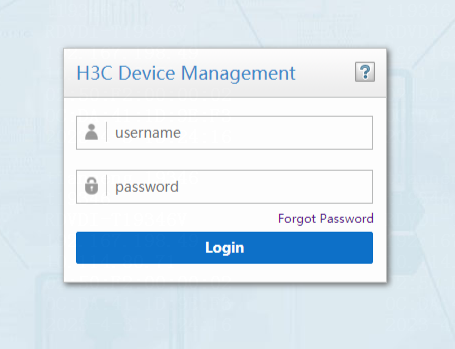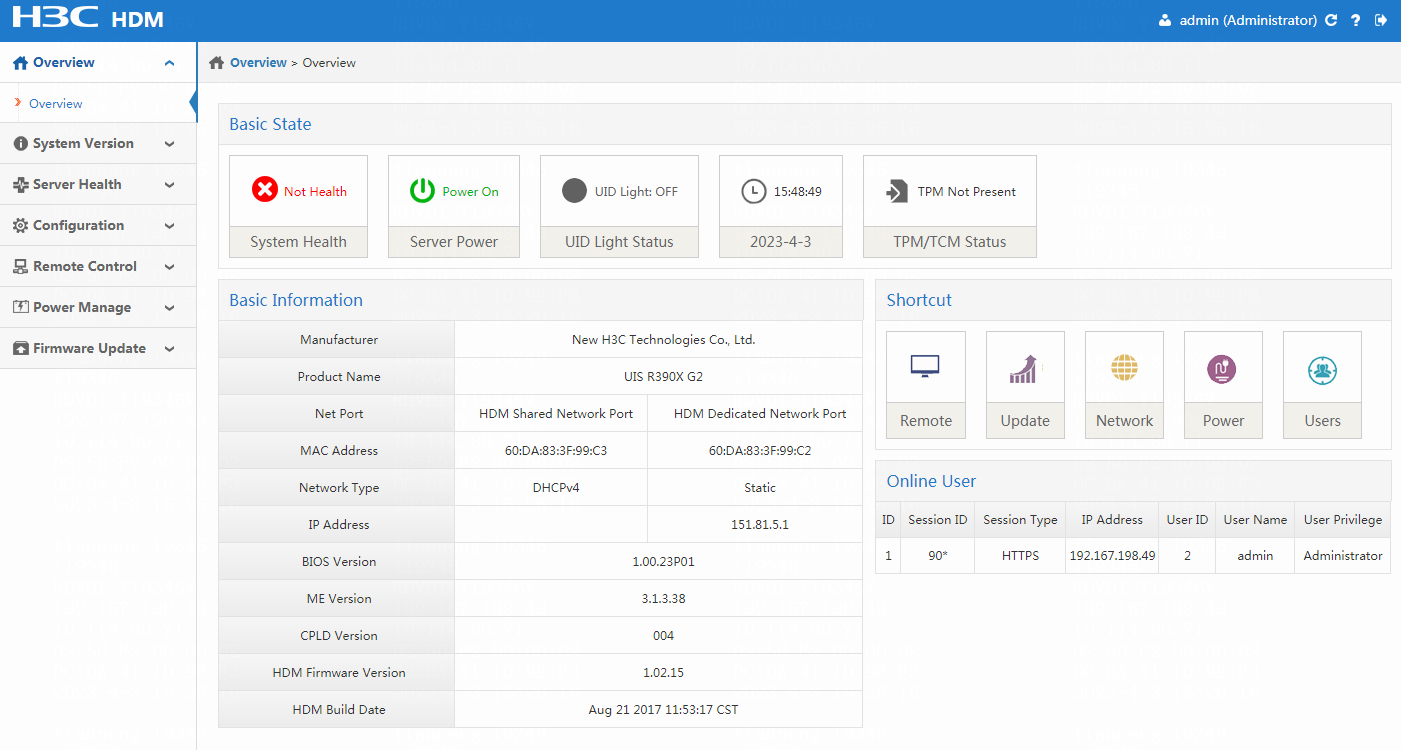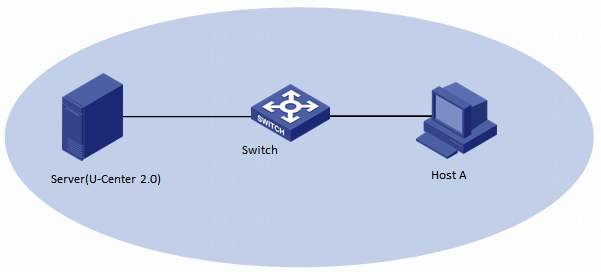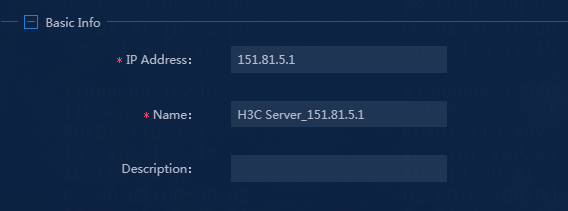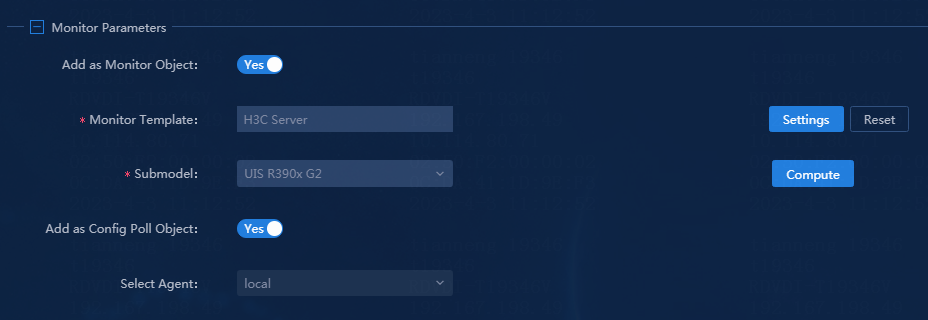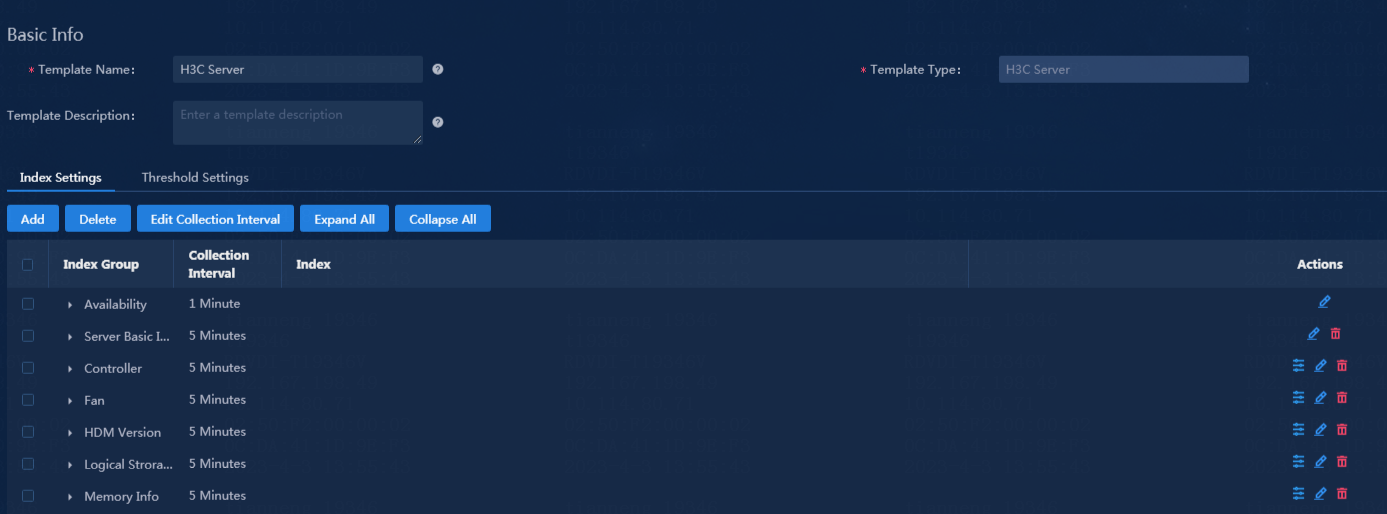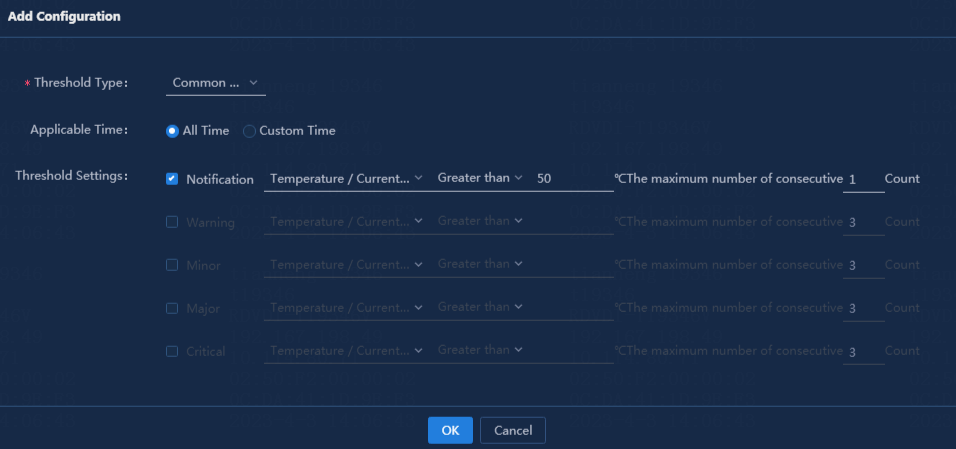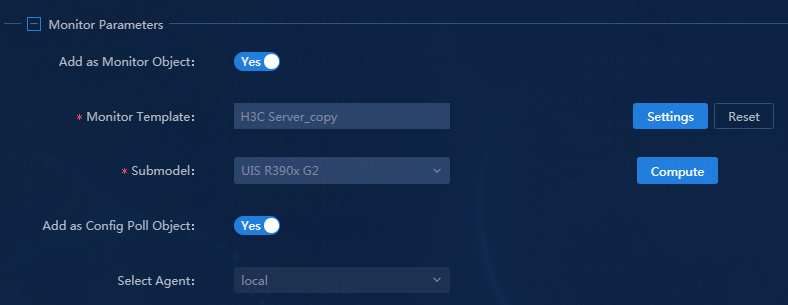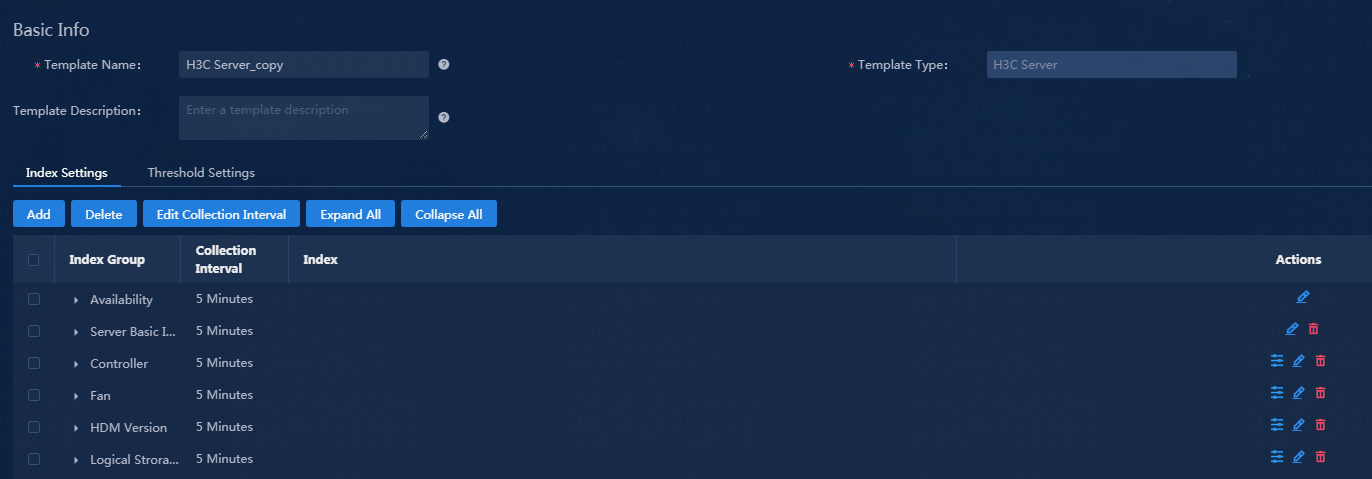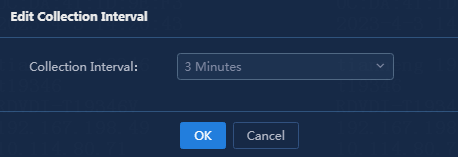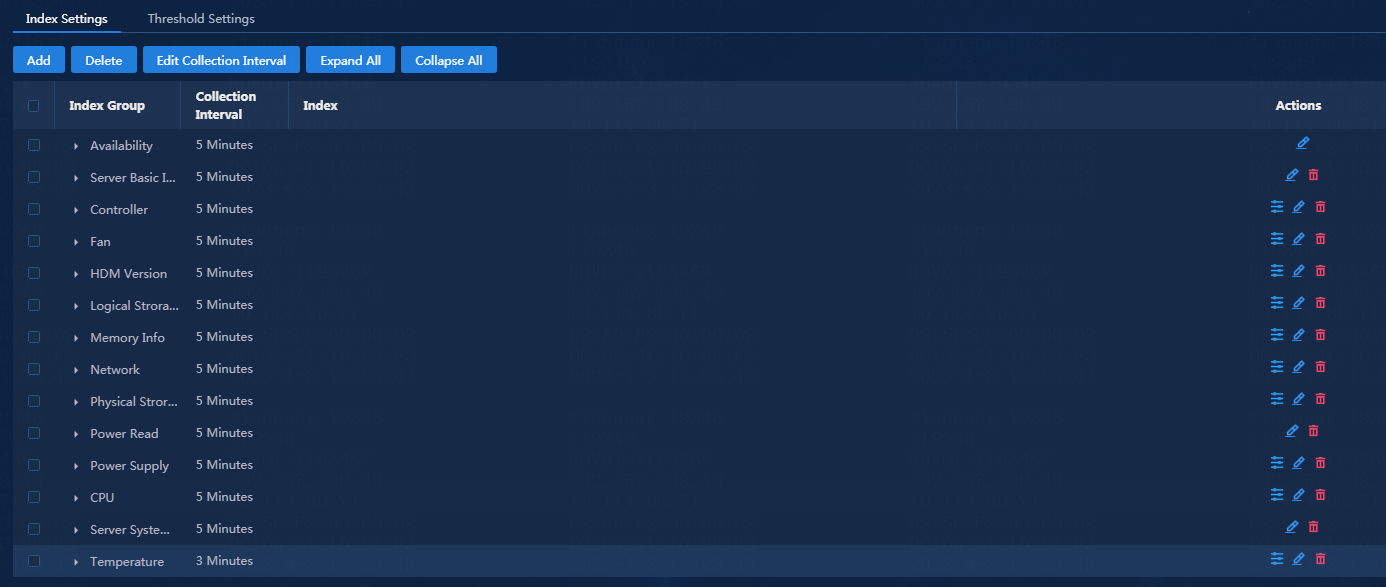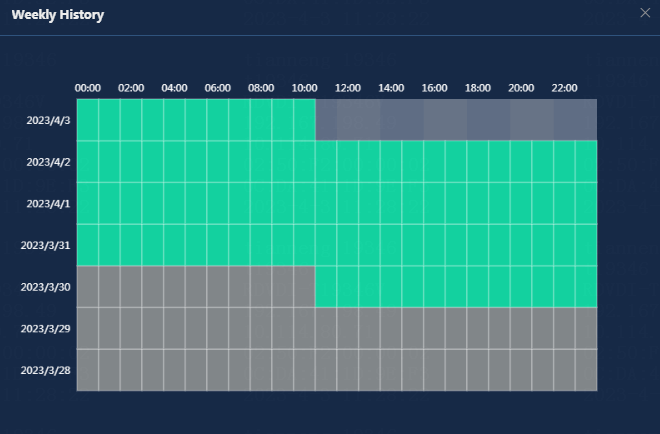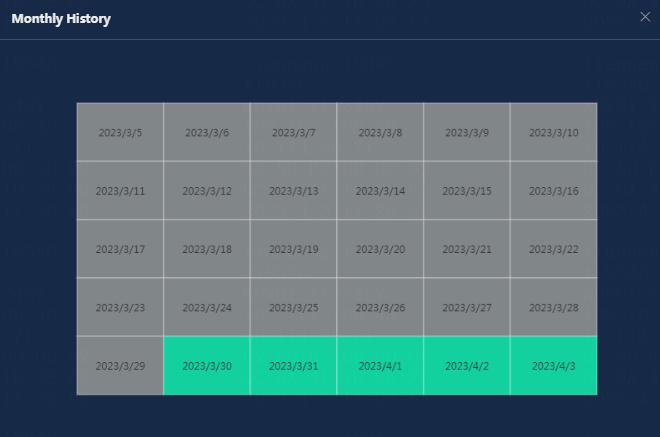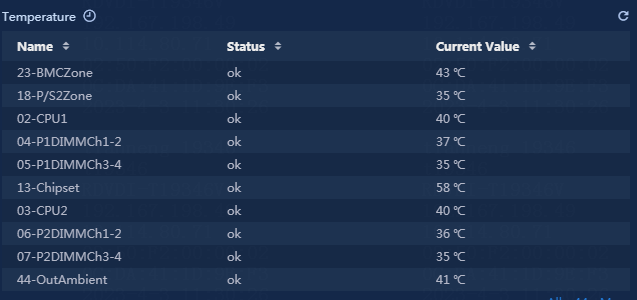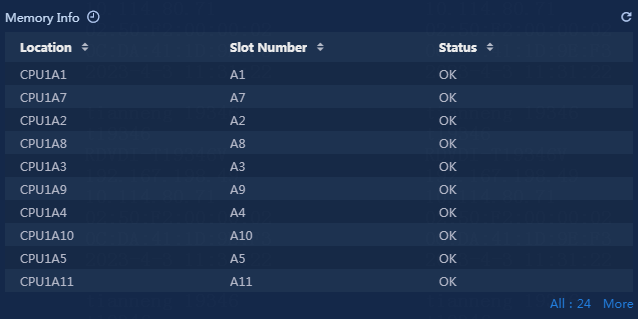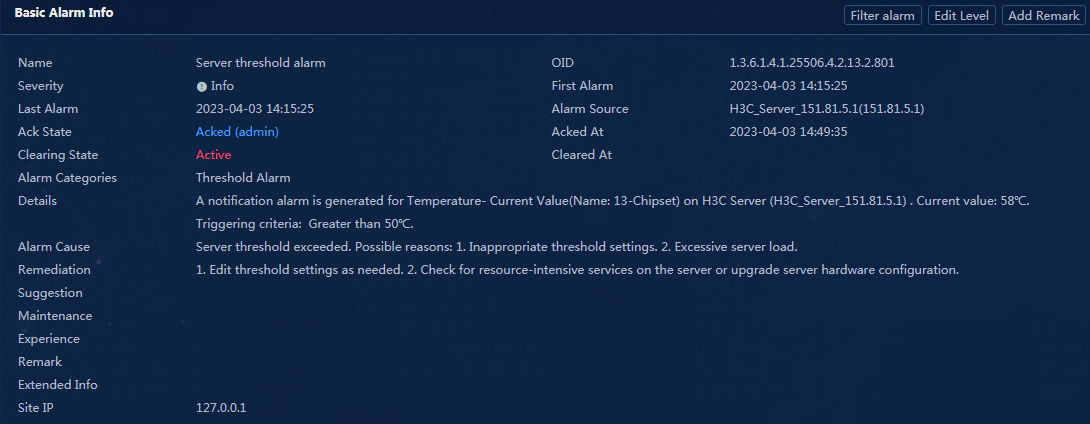- Released At: 15-01-2024
- Page Views:
- Downloads:
- Table of Contents
- Related Documents
-
UIS R390X G2 Server Monitoring in U-Center 2.0
Configuration Example
Document version: 5W102-20230922
Copyright © 2023 New H3C Technologies Co., Ltd. All rights reserved.
No part of this manual may be reproduced or transmitted in any form or by any means without prior written consent of New H3C Technologies Co., Ltd.
Except for the trademarks of New H3C Technologies Co., Ltd., any trademarks that may be mentioned in this document are the property of their respective owners.
The information in this document is subject to change without notice.
Contents
Configuring an H3C Server monitor template
Viewing the H3C Server monitor report
Viewing H3C Server threshold alarms
Introduction
The Intelligent Platform Management Interface (IPMI) is a standard used for server management systems to provide unified management of different types of server hardware systems. IPMI reads hardware information through a separately powered Baseboard Management Controller (BMC) chip on the motherboard and its own logging system. To ensure comprehensive management, SNMP protocol and REST interface may be used to supplement IPMI due to private properties of servers from different manufacturers.
This document describes how to use U-Center 2.0 to incorporate UIS R390X G2 servers to demonstrate server incorporation through IPMI.
Usage guidelines
Application scenarios
This document is applicable in the scenario where U-Center 2.0 monitors UIS R390X G2 servers.
Prerequisites
· Make sure U-Center 2.0 has been installed and deployed and U-Center 2.0 can communicate with the UIS R390X G2 server correctly.
· To manage a server in U-Center 2.0, make sure an administrator account that can access the HDM interface of the server is available. You can contact the server administrator to obtain the username, password, and port number.
¡ Verify if you can log in to the management interface with the given username and password, as shown in Figure 1.
¡ Verify that you can view server information on webpages, as shown in Figure 2.
¡ The UIS R390X G2 server uses the default IPMI port number 623. You can access the HDM server settings menu to view or change the port number to use, as shown in Figure 3. The path varies by HDM version.
Figure 1 Logging in to the management interface
Figure 2 Basic server information
Figure 3 Viewing the service ports
Configuration example
Network configuration
As shown in Figure 4, a UIS R390X G2 server is installed in the DC of a company to provide services for the company. The server administrator needs to use U-Center 2.0 to incorporate and monitor the UIS R390X G2 server, as shown in Table 1.
Figure 4 Network diagram
Table 1 Network deployment details
|
Host name |
IP address |
Application |
|
Server (U-Center 2.0) |
192.167.253.159 |
U-Center IOM 2.0 (E0710) |
|
Host A |
151.81.5.1 |
HDM 1.02.15 |
Procedure
Adding a server monitor
1. Log in to U-Center 2.0.
2. Click the Monitor tab.
3. From the left navigation pane, select Basic Monitor > Servers.
4. Click Add, and select H3C Server as the monitor template and UIS R390x G2 as the submodel.
The server adding page opens as shown in Figure 5.
5. Configure basic information, as shown in Figure 6.
Figure 6 Configuring basic information
¡ IP Address: Enter the IP address of the H3C Server UIS R390x G2 server. In this example, the address is 151.81.5.1.
¡ Name: Use the automatically generated server name in U-Center 2.0. In this example, the name is H3C Server_151.81.5.1. You can change the name as needed. This example uses the default name.
¡ Description: Enter the application description.
6. Configure monitoring parameters, as shown in Figure 7.
Figure 7 Configuring monitoring parameters
¡ Add as Monitor Object: Select whether to add resource objects as monitor objects. You must enable Add as Monitor Object, Add as Config Poll Object, or both.
¡ Monitor Template: Use the default H3C Server template predefined U-Center 2.0. You can click Settings to select another monitor template or edit the monitor template settings. For more information about how to edit a monitor template, see "Configuring an H3C Server monitor template."
¡ Submodel: Specify the model of the server to be monitored. In this example, the submodel is UIS R390x G2. In U-Center 2.0, you can click Compute to calculate and obtain the unit indicator set for units that are not supported by this model.
¡ Add as Config Poll Object: By default, this option is enabled. To use the Add as Config Poll Object function, you must purchase the corresponding license for the CMDB product to obtain the quantity-based authorization and functional authorization. Without the license, the page does not display the parameter.
¡ Select Agent: Specify the management station for the monitor. The default agent is Local. This parameter is not specified in this example. In the proxy scenario, you must use proxy to incorporate applications (select Proxy as the agent for the monitor).
7. Configure access parameters, as shown in Figure 8.
Figure 8 Configuring the access parameters
¡ Monitoring Protocol: IPMI is preset in the system. H3C Server UIS R390x G2 is a pure IPMI-managed device and does not require SNMP parameter configuration.
¡ Username/Password: Enter the username of an HDM operator account and the password.
The system can monitor only server CPU and memory usage, some system information, physical disk information, services, interfaces, processes, and system time indicators. IPMI cannot monitor other information, such as event logs and I/O status.
¡ Port: The UIS R390X G2 server uses the default IPMI port number 623. This example uses the default setting. You can access the HDM server settings menu to change the port number as needed.
8. Configure log access parameters, as shown in Figure 9. This example uses the default settings.
Figure 9 Configuring log access parameters
¡ Enable Log Monitoring: Monitor and collect server logs. By default, this feature is disabled.
¡ Collect All Logs: This option is configurable only when log monitoring is enabled. By default, this feature is disabled.
- If you select not to enable this feature, the system collects only logs generated afterwards.
- If you select to enable this feature, the system collects all logs, including logs that have been generated.
¡ Log Template: A template saves log access parameters to help operators quickly configure log access for servers.
¡ Polling Interval (Min): Interval at which server logs are collected. By default, the interval is 30 minutes.
9. Configure resource group settings for the monitored object as needed to facilitate resource management, as shown in Figure 10. This parameter is not specified in this example.
Figure 10 Configuring resource group settings
10. Enable detection as needed. The default setting is enabled, as shown in Figure 11. This example uses the default settings.
Figure 11 Configuring other information
11. Click Test Connectivity to identify whether the parameters are correctly configured.
12. If the connectivity test is passed, click OK.
The server list displays the added server, as shown in Figure 12.
Configuring an H3C Server monitor template
U-Center 2.0 uses monitor templates to control the collection indexes and their threshold values, and provides a large number of monitor templates available for use. You can also modify the monitor templates as needed for personalized monitoring.
You can set threshold values for the concerned indexes to monitor the application running status by monitoring the resource alarm status. Common operations include:
· Copy a monitor template and edit the threshold settings. For more information, see "Editing threshold settings."
· Edit the index collection interval. For more information, see "Editing the collection interval for an index group."
To configure an H3C Server monitor template:
1. Click the Monitor tab.
2. From the left navigation pane, select Monitor Options > Monitor Templates, as shown in Figure 13.
Figure 13 Monitor template list
3. In the Select Template Type area, select Server > H3C > H3C Server to view the H3C Server monitor template, as shown in Figure 14. The Actions column provides the following functions:
¡ To
edit a monitor template, click the ![]() icon.
icon.
¡ To
copy a monitor template, click the ![]() icon. For
example, if you copy monitor template A, the system generates monitor template A_copy.
You can edit and save the new template on the page for copying the template.
icon. For
example, if you copy monitor template A, the system generates monitor template A_copy.
You can edit and save the new template on the page for copying the template.
¡ To
edit the threshold settings of a monitor template, click the ![]() icon.
icon.
Figure 14 Configuring an H3C Server monitor template
Editing threshold settings
As a best practice, do not edit the indexes in the predefined monitor templates of the system. As a best practice to edit multiple parameters, first copy the monitor template, edit the parameters in the copied template, and then configure the edited monitor template for the application.
This example modifies the Current Value index in Temperature index group as an example.
To edit threshold settings:
1. Click the copy icon ![]() to
access the template monitoring page.
to
access the template monitoring page.
2. On the Index Settings tab, expand Temperature item, as shown in Figure 15.
Figure 15 Temperature index group
3. Click the ![]() icon in the Actions
column for the Current Value index, and configure the following
parameters in the window that opens. See Figure 16.
icon in the Actions
column for the Current Value index, and configure the following
parameters in the window that opens. See Figure 16.
¡ U-Center 2.0 supports multiple threshold types, including Common Threshold, Composite Threshold, Index-Based Rule, and Instance Loss Threshold. Different types require different configurations. Choose the threshold value type as needed, set the operator, and select the threshold level. The threshold types of some indexes have been predefined in U-Center 2.0, and cannot be edited. In this example, the common threshold is selected.
¡ For the current value index, this example enables the Notification level and sets the threshold value and trigger times separately. The operator is set to Larger than. When the temperature exceeds the threshold value and the trigger count is reached, the system generates a notification alarm.
¡ Applicable Time: You can select all time or customize a time range. For custom time, any time period from Monday to Sunday is supported. In this example, all time is selected.
Figure 16 Editing threshold settings
4. Click OK to save the edited parameters, as shown in Figure 17.
Figure 17 Edited threshold settings
5. If you do not need to edit other parameters in the monitor template, you must click OK at the bottom of the page to save your modification.
The copied monitor template is created successfully, as shown in Figure 18.
Figure 18 Added monitor template
6. Re-enter the H3C Server monitor page to replace the monitor template and save it, as shown in Figure 19. The system will use the new monitor template at the next collection interval.
Figure 19 Editing the monitor template
Editing the collection interval for an index group
U-Center 2.0 controls the interval for collecting indexes through monitor templates. You can specify different collection intervals for different index groups.
To edit the collection interval for an index group:
1. Click the Monitor tab.
2. From the left navigation pane, select Monitor Options > Monitor Templates.
3. Click the edit icon ![]() in the
Actions column of H3C Server_copy to enter the page for editing
the monitor template, as shown in Figure 20.
in the
Actions column of H3C Server_copy to enter the page for editing
the monitor template, as shown in Figure 20.
The list displays monitor indexes for the monitor template. The default collection interval is 5 minutes. This example configures the collection interval for the Temperature index group.
Figure 20 Editing the monitor template
4. Select the Temperature index group, and click Edit Collection Interval. The Edit Collection Interval page opens, as shown in Figure 21.
Figure 21 Editing the collection interval
5. Select a collection interval from the Collection Interval list. In this example, the interval is set to 3 minutes.
6. Click OK. The edited collection interval is as shown in Figure 22.
Figure 22 Collection interval modified successfully
7. Click OK. The edited monitor template automatically takes effect at the next collection interval.
Verifying the configuration
Viewing the H3C Server monitor report
1. Click the Monitor tab.
2. From the left navigation pane, select Basic Monitor > Servers. Verify that the alarm state has changed after a period of collection, as shown in Figure 23.
Figure 23 Viewing the server list
3. Click the name link. In the dialog box that opens, view the resource details, as shown in Figure 24.
This section uses indexes defined in the default monitor template for the UIS R390X G2 to describe fields in the monitor report.
Figure 24 Server resource details (part)
Basic information
View basic server information on the monitoring dashboard, as shown in Figure 25.
Figure 25 Basic server information
· Product Name: Model of the server.
· Serial Number: Serial number of the server.
· System Status: System state of the server.
Availability Today
View the Availability Today section on the monitor dashboard, as shown in Figure 26.
· Pie Chart: Percentage of availability status for the application in the current day. You can view the corresponding percentage data for each pie slice by hovering over it with the mouse.
· Current Availability: Availability of the current application.
¡ Available: Total accumulated time that the application has been running normally since 00:00 today.
¡ Unavailable: Total accumulated duration of protocol connection failures for the application since 00:00 today.
¡ Collect Disabled: Total accumulated duration of collection stoppage for the application since the user manually disabled monitoring and collection for the device.
· For a newly added application monitor, the system starts collecting statistics for the Available, Unavailable, and Collect Disabled fields since the monitor is successfully added on the current day. The availability status data with duration of 0 are not displayed.
· Weekly History: To view the availability of the application in the past 7 days, click Weekly History. The system calculates the availability of an application for the past 7 days by hour, as shown in Figure 27. To view the percentage of each server's availability status, hover over a corresponding time period.
· Monthly History: To view the availability of the application in the past 30 days, click Monthly History. The monthly availability data is collected in days. To view the percentage of each server's availability status, hover over a corresponding time period.
Fan information
View fan information on the monitoring dashboard, as shown in Figure 29.
Figure 29 Fan information
· Name: Fan name.
· Status: Fan status.
· Speed: Rotation speed.
Temperature information
View temperature information on the monitoring dashboard, as shown in Figure 30.
· Name: Component name.
· Status: Component status.
· Current Value: Current temperature of the component.
CPU information
View CPU information on the monitoring dashboard, as shown in Figure 31.
· Name: CPU name.
· Model: CPU model.
· Frequency: CPU frequency.
· Status: CPU status.
Memory information
View memory information on the monitoring dashboard, as shown in Figure 32.
· Location: Memory location.
· Slot Number: Memory slot number.
· Status: Memory status.
Power supply information
View power supply information on the monitoring dashboard, as shown in Figure 33.
Figure 33 Power supply information
· Model: Power supply model.
· Serial Number: Power supply serial number.
· Presence: In-position status of the power supply.
· Status: Power supply status.
Power read information
View power read information on the monitoring dashboard, as shown in Figure 34.
Current power: Current power read.
Network adapter information
View network adapter information on the monitoring dashboard, as shown in Figure 35.
· Port: Port on the network adapter.
· MAC Address: MAC address of the network adapter.
Physical storage information
View physical storage information on the monitoring dashboard, as shown in Figure 36.
· Location: Location of the physical storage.
· Serial Number: Serial number of the physical storage.
· Status: Status of the physical storage.
Logical storage information
View logical storage information on the monitoring dashboard, as shown in Figure 37.
· Type: Type of the logical storage.
· Status: Status of the logical storage.
HDM version information
View HDM version information on the monitoring dashboard, as shown in Figure 38.
· Name: Firmware name.
· HDM Version: Firmware version.
Viewing H3C Server threshold alarms
1. Access the H3C Server resource details page.
The monitor dashboard tab displays the name, type, health status, and suspension state of the monitored application. If an application has triggered alarms of different levels, the Health Status field displays the highest level of alarms triggered.
Based on the configuration in this example, H3C Server will generate alarms of the Notification level and display alarms of the Notification level in the health status field, as shown in Figure 39.
Figure 39 H3C Server monitor dashboard
2. Click the health status link or select the alarm information tab to enter the alarm information page, as shown in Figure 40.
3. Click the alarm information link to view the alarm details, as shown in Figure 41.
Figure 41 Notification-Alarm details
4. After you receive a threshold alarm, verify if the related information is correct, and then click the Unacked link in the Ack State column to acknowledge the alarm.
5. Resolve issues that trigger the alarm or adjust the alarm threshold, and then click Active in the Clearing State column to clear the alarm.
U-Center 2.0 periodically monitors applications. If the collected index values do not meet the threshold conditions in the next collection interval, the alarm status will be automatically restored and new index values will be recorded.
After all alarms are recovered, the health status of the application will also be restored to normal, as shown in Figure 44.
Figure 44 Alarm status recovered

